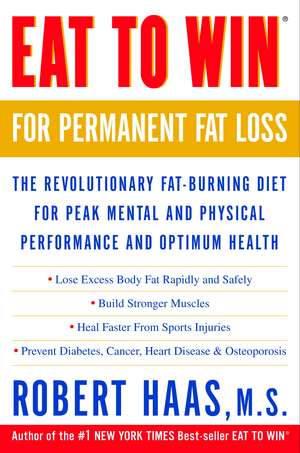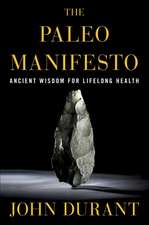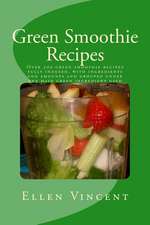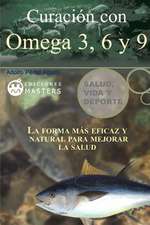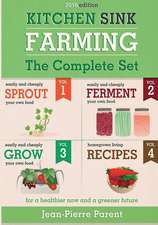Eat to Win for Permanent Fat Loss: The Revolutionary Fat-Burning Diet for Peak Mental and Physical Performance and Optimum Health
Autor Robert Haasen Limba Engleză Paperback – 30 apr 2001
Based on cutting-edge research on how and why our bodies use carbohydrates, proteins, and fats, Haas created a "Mediterrasian" diet that combines the best and healthiest aspects of diets from the regions where people live the longest. His approach features a ratio of 50 percent carbohydrates, which includes grains, fruits, and vegetables; 25 percent protein; and 25 percent fat. Haas also provides the specific reasons why this is the ultimate ratio for maximum energy, fitness, and permanent fat loss.
Eat to Win for Permanent Fat Loss offers a remarkably flexible, healthy food plan that encourages both the use of the new "functional" foods, such as tofu hot dogs and soy-chicken nuggets, and treats that most diet plans forbid entirely, such as chocolate, wine, and coffee. In fact, Haas tells you why enjoying chocolate and coffee every day could actually make you healthier, providing both satisfaction and valuable phytonutrients that prevent illness. It's the kind of eating plan that works for the entire family.
As for exercise, Haas's recommendation is just as simple: Burn a minimum of 300 calories--the equivalent of 45 minutes of walking--throughout the day, through any activity you choose. Haas’s combined diet and exercise program changes lives.
Preț: 113.87 lei
Nou
Puncte Express: 171
Preț estimativ în valută:
21.79€ • 22.72$ • 18.11£
21.79€ • 22.72$ • 18.11£
Carte disponibilă
Livrare economică 28 februarie-14 martie
Preluare comenzi: 021 569.72.76
Specificații
ISBN-13: 9780609807620
ISBN-10: 0609807625
Pagini: 288
Ilustrații: CHARTS
Dimensiuni: 156 x 234 x 19 mm
Greutate: 0.39 kg
Ediția:Revised
Editura: HARMONY
ISBN-10: 0609807625
Pagini: 288
Ilustrații: CHARTS
Dimensiuni: 156 x 234 x 19 mm
Greutate: 0.39 kg
Ediția:Revised
Editura: HARMONY
Notă biografică
ROBERT HAAS, M.S., is a renowned health expert who has counseled such world-champion athletes and celebrities as Martina Navratilova, Ivan Lendl, Cher, Carly Simon, and Mike Nichols. He also serves as a consultant to the health and fitness industry and has a nutrition counseling practice in Miami, Florida.
Extras
A book like this comes along only twice in a lifetime.
Back in the dark ages of sports nutrition—circa 1980—athletes and active people had no idea that specific foods, beverages, and dietary supplements could help burn off excess body fat, boost energy and endurance, sharpen reflexes, and maximize muscular development. In fact, most coaches, trainers, and team physicians believed that nutrition played only a minor role, at best, in fueling the fires of stamina, endurance, and peak athletic performance.
Were they ever wrong!
Tennis superstars Ivan Lendl and Martina Navratilova, like many other professional athletes during the 1980s, found religion in a new dietary doctrine. Their bible: a book I'd written called Eat to Win. Each became a true believer, won over after following a radical sports nutrition system that helped them shed excess body fat, build muscle, and achieve boundless energy and endurance. They publicly credited the Eat to Win plan with helping them lose excess body fat and boost their energy levels to dominate their sport and decimate their opponents.
In 1992, after winning an Olympic gold medal in the heptathlon event, Jackee Joyner-Kersee publicly recommended the Eat to Win plan to all aspiring Olympic athletes. Jackee's record includes three number-one rankings in the long jump and five more in the heptathlon and also two more Olympic gold medals, a silver and two bronzes, and another four gold medals in the outdoor World championships.
U.S. Olympic skiers, professional golfers, world-heavyweight boxers, football and baseball pros, race car drivers, swimmers, soccer players, and other martial artists, Wall Street traders, television and motion picture celebrities, and recording artists joined the growing ranks of eat-to-winners. Some athletes used the Eat to Win plan to earn a coveted entry in the Guinness Book of World Records. One physically challenged athlete, who had lost a leg to cancer, embraced the Eat to Win plan to help him run across the country.
Athletes past their prime competitive years soon discovered the rejuvenating powers of the Eat to Win plan. Golf legend Jack Nicklaus and Wimbledon champion Fred Stolle used the plan to shed difficult-to-lose pounds they had gained over the years. Tennis champions Stan Smith, Gene Mayer, and Harold Solomon embraced the plan to give them more energy and thereby prolong their professional careers. Today, former world-champion boxer George Foreman publicly recommends my dietary plan to all aspiring young athletes who want to lose excess body fat and gain a competitive advantage over opponents.
Despite the unrivaled track record of the Eat to Win plan, members of the American Dietetic Association and the American Medical Association disputed the value of eating a special diet to boost athletic performance and endurance. Instead, they recommended that a "balanced" diet of choices made from the common food groups was the best way for all people, including athletes, to eat. Their idea of a balanced diet included plenty of animal protein—a recommendation that opened the door to the protein pushers.
The advent of the protein pushers—diet book authors who promoted high intakes of animal protein foods for weight loss and better health—proved to be a major step backward in the evolution of nutritional science. Several physicians and self-proclaimed nutritionists (who, themselves, clearly carry body fat levels that exceed federal health guidelines) wrote self-help books touting the power of high-protein diets for athletes and couch potatoes alike. Carbohydrates, they maintained, could cripple sports performance and endurance while making people fat; protein and fat, they alleged, should form the foundation of a healthy and slimming diet. The protein pushers seduced a trusting public with sweet promises of permanent fat loss they couldn't keep. Worse yet, they touted the virtues of a performance-robbing diet based on such artery-clogging foods as filet mignon, ground beef, pastrami, mayonnaise, cheese, bacon, and heavy cream.
Instead of giving people a healthy way to lose weight and gain fitness, the protein pushers may have given their readers a head start on cardiovascular disease, breast, colon and prostate cancer, and osteoporosis. A growing body of research has linked all of these serious health problems to high-protein andor high-fat diets.
A few diet book authors have been able to see an individual tree or two, but none has succeeded in showing readers the entire weight-loss forest. Eat to Win for Permanent Fat Loss aims to do that. It explains for the first time exactly how we lose body fat, why we lose body fat, which foods rev up and shut down the body's fat-burning furnace. It reveals why eating foods that control the body's glycogen (stored carbohydrate) level is the key to achieving permanent fat loss and regulating appetite and satiety. You will learn exactly how and why your body uses carbohydrates, proteins, and fats the way it does, which foods add fat to your body and which ones do not. For the first time in your life, the secrets of permanent fat loss will be within your grasp.
The nutritional strategies for achieving lifetime slimness and boosting physical and mental performance are based on my research with world champion athletes and ordinary people and on the findings of thousands of research studies published during the last twenty years. Eat to Win for Permanent Fat Loss is the evolutionary product of the original Eat to Win plan. It is the fat-burning, high-energy nutrition bible for the new century.
Back in the dark ages of sports nutrition—circa 1980—athletes and active people had no idea that specific foods, beverages, and dietary supplements could help burn off excess body fat, boost energy and endurance, sharpen reflexes, and maximize muscular development. In fact, most coaches, trainers, and team physicians believed that nutrition played only a minor role, at best, in fueling the fires of stamina, endurance, and peak athletic performance.
Were they ever wrong!
Tennis superstars Ivan Lendl and Martina Navratilova, like many other professional athletes during the 1980s, found religion in a new dietary doctrine. Their bible: a book I'd written called Eat to Win. Each became a true believer, won over after following a radical sports nutrition system that helped them shed excess body fat, build muscle, and achieve boundless energy and endurance. They publicly credited the Eat to Win plan with helping them lose excess body fat and boost their energy levels to dominate their sport and decimate their opponents.
In 1992, after winning an Olympic gold medal in the heptathlon event, Jackee Joyner-Kersee publicly recommended the Eat to Win plan to all aspiring Olympic athletes. Jackee's record includes three number-one rankings in the long jump and five more in the heptathlon and also two more Olympic gold medals, a silver and two bronzes, and another four gold medals in the outdoor World championships.
U.S. Olympic skiers, professional golfers, world-heavyweight boxers, football and baseball pros, race car drivers, swimmers, soccer players, and other martial artists, Wall Street traders, television and motion picture celebrities, and recording artists joined the growing ranks of eat-to-winners. Some athletes used the Eat to Win plan to earn a coveted entry in the Guinness Book of World Records. One physically challenged athlete, who had lost a leg to cancer, embraced the Eat to Win plan to help him run across the country.
Athletes past their prime competitive years soon discovered the rejuvenating powers of the Eat to Win plan. Golf legend Jack Nicklaus and Wimbledon champion Fred Stolle used the plan to shed difficult-to-lose pounds they had gained over the years. Tennis champions Stan Smith, Gene Mayer, and Harold Solomon embraced the plan to give them more energy and thereby prolong their professional careers. Today, former world-champion boxer George Foreman publicly recommends my dietary plan to all aspiring young athletes who want to lose excess body fat and gain a competitive advantage over opponents.
Despite the unrivaled track record of the Eat to Win plan, members of the American Dietetic Association and the American Medical Association disputed the value of eating a special diet to boost athletic performance and endurance. Instead, they recommended that a "balanced" diet of choices made from the common food groups was the best way for all people, including athletes, to eat. Their idea of a balanced diet included plenty of animal protein—a recommendation that opened the door to the protein pushers.
The advent of the protein pushers—diet book authors who promoted high intakes of animal protein foods for weight loss and better health—proved to be a major step backward in the evolution of nutritional science. Several physicians and self-proclaimed nutritionists (who, themselves, clearly carry body fat levels that exceed federal health guidelines) wrote self-help books touting the power of high-protein diets for athletes and couch potatoes alike. Carbohydrates, they maintained, could cripple sports performance and endurance while making people fat; protein and fat, they alleged, should form the foundation of a healthy and slimming diet. The protein pushers seduced a trusting public with sweet promises of permanent fat loss they couldn't keep. Worse yet, they touted the virtues of a performance-robbing diet based on such artery-clogging foods as filet mignon, ground beef, pastrami, mayonnaise, cheese, bacon, and heavy cream.
Instead of giving people a healthy way to lose weight and gain fitness, the protein pushers may have given their readers a head start on cardiovascular disease, breast, colon and prostate cancer, and osteoporosis. A growing body of research has linked all of these serious health problems to high-protein andor high-fat diets.
A few diet book authors have been able to see an individual tree or two, but none has succeeded in showing readers the entire weight-loss forest. Eat to Win for Permanent Fat Loss aims to do that. It explains for the first time exactly how we lose body fat, why we lose body fat, which foods rev up and shut down the body's fat-burning furnace. It reveals why eating foods that control the body's glycogen (stored carbohydrate) level is the key to achieving permanent fat loss and regulating appetite and satiety. You will learn exactly how and why your body uses carbohydrates, proteins, and fats the way it does, which foods add fat to your body and which ones do not. For the first time in your life, the secrets of permanent fat loss will be within your grasp.
The nutritional strategies for achieving lifetime slimness and boosting physical and mental performance are based on my research with world champion athletes and ordinary people and on the findings of thousands of research studies published during the last twenty years. Eat to Win for Permanent Fat Loss is the evolutionary product of the original Eat to Win plan. It is the fat-burning, high-energy nutrition bible for the new century.
Descriere
Sports medicine expert Haas shows readers how to lose fat and keep it off with a well-balanced diet of carbohydrates, protein, fat, and supplements, and controlling levels of glycogen, the form in which the body stores carbohydrates and controls appetite and fat burning. Charts.
